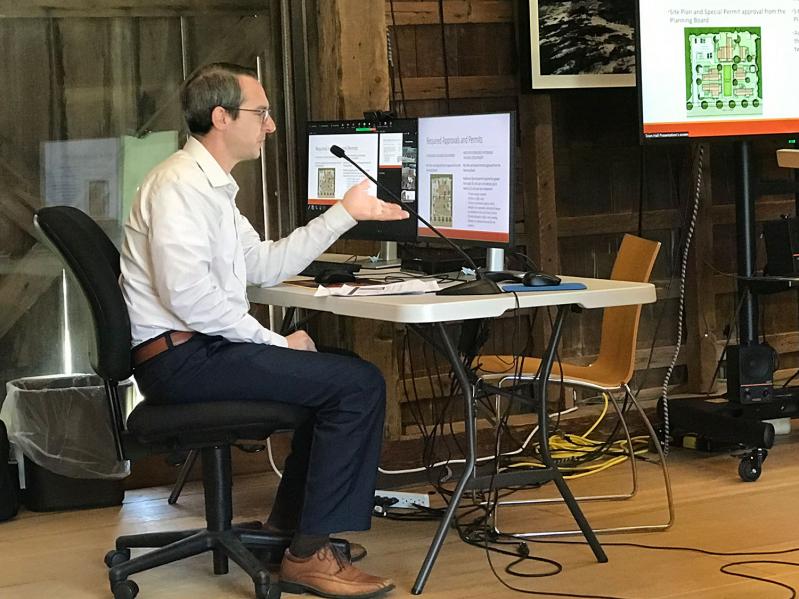A new approach to East Hampton Town’s work force housing crisis was introduced at Tuesday’s town board work session that could, if the zoning code is amended to allow it, alleviate the current crunch. The change would, in essence, encourage employers — Stony Brook Southampton Hospital being a prime example — to build and sponsor affordable housing for their employees.
“Anybody who lives here knows the reality is that people who work here, cannot afford to live here,” said Councilman Ian Calder-Piedmonte. “We are importing our workers and services from outside. Town-sponsored projects are incredibly important; however, we can’t do it all. Code changes that can allow for businesses and developers to also help solve these problems with non-town money would be great.”
The concept would allow local businesses to house their workers in a multiunit development, with the employers owning the units and renting them to the employees. There would be no income restriction on residents, but rent restrictions would be the same as in any affordable housing complex in town: Occupants could earn up to 130 percent of the area’s median income.
For example, the two-person income limit is roughly $160,000. “If Stony Brook Southampton Hospital wants to purchase one of these units, and they have two young doctors and they each made $82,000, they wouldn’t be able to be housed,” Eric Schantz, the town’s director of housing and community development, told the bord. Citing that example, he said it would be a good idea to waive the income limit.
“The caveat would be that we restrict this use to what we want it to be — that’s going to be a challenge,” said Mr. Calder-Piedmonte. “Maybe we want to look at specific jobs. Do we want a company that has social influencers to have employer-sponsored housing and house their people to come and have summer fun in the Hamptons? Probably not!”
In order to account for the yearly boom in seasonal workers, the leases would have to differ from the norm in length, with terms as short as 90 days (affordable developments have a minimum term of a year). In addition, such housing could be allowed only in districts already zoned for it, on lots that are at least three acres. “The scope of this use is limited, and the reach is limited by the fact that there are only two sites where this can be done,” said Mr. Schantz. One is behind the Amagansett Fire Department, the other is at 350 Pantigo Road in East Hampton, last occupied by the old Stern’s department store.
The town board indicated that it may ultimately may add more parcels to the so-called affordable housing overlay district, and the discussion was all preliminary, including the possibility of increasing density from eight units per acre to 12, with a special permit from the planning board. To obtain the permit, Mr. Schantz said, developers would need to provide, at the very least, sewage treatment and a traffic study.
“Traffic is going to be a concern,” he said. “It’s something we’re going to have to take a very hard look at.”
Earlier in the meeting the board had considered the same code change, from eight units to 12, while discussing affordable housing for senior citizens, and Mr. Schantz had said the main environmental impacts from the increased density would be felt on the roads and in the groundwater.
However, using numbers from the Institute of Transportation Engineers Trip Generation Manual, he also indicated that senior housing generates less traffic on weekdays — half as much, compared to other affordable units, and a third compared to single-family residences.
As for the effects on groundwater, Mr. Schantz said the County Department of Health assigns a lower rate of sanitary flow to senior residences, 100 gallons per day, versus the 150 allotted to regular affordable housing complexes. He recommended the board issue the density-increase proposal, at least where senior housing is concerned, a negative declaration, per the New York State Environmental Review Act. Members agreed, and a resolution will be voted on at an upcoming meeting.
“I don’t by any stretch of the imagination think I handed you something that is gold,” Mr. Schantz said, referring again to the employer-owned concept. He acknowledged that there could be issues there; working out how common areas of buildings are maintained and allowing for culture clashes among employees. “We need to make sure there are safeguards provided, to make sure that there is proper management of the facilities,” he said.
Board members seemed unconvinced. Supervisor Kathee Burke-Gonzalez raised a question about lease terms, especially if an employee were laid off, but supported the idea conceptually. Councilwoman Cate Rogers wondered how increased density would affect parking. and questioned the tax implications of such developments, while appreciating the new way of looking at an old problem.
“I have grave concerns over this as a concept,” said Councilman Tom Flight, suggesting that finding the balance between year-round residents and seasonal workers would be tricky. Councilman David Lys worried that the proposal might inadvertently help larger, well-funded businesses, at the expense of smaller.
“As a use, I am wholeheartedly a believer that this is necessary,” said Mr. Calder-Piedmonte. “The idea is, we wanted to put out the concept and hear feedback so we can refine it and decide if it’s an appropriate thing to do or not.”




